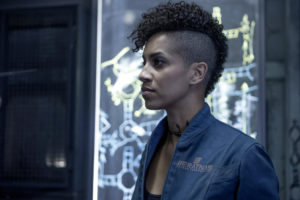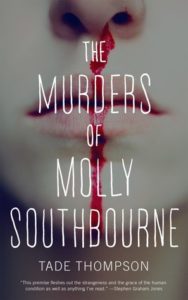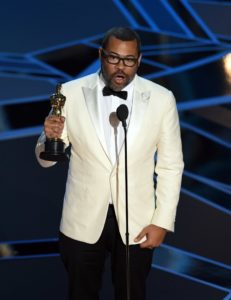In honor of Black History Month, and this month’s book club selection, How Long ‘Til Black Future Month?, we’re taking a look at the Black creators and performers who inspire us and lead the way towards the future. Who is your favorite? Maybe they made the cut! Read on for more!
Jasika Nicole does everything. We all probably know her best as intrepid Walter-minder Astrid Farnsworth from Fringe. But you can also hear Jasika on the suspense/horror podcasts Welcome To Nightvale as Dana Cardinal, Cecil’s longest-surviving intern (or her double!) and Nightvale’s last Mayor (and murder suspect—or was it her double?), and Alice Isn’t Dead, as Keisha the lovelorn anxiety-burdened truck driver seeking her lost wife (there are so many things right about this portrayal of someone with anxiety). Currently she is part of The Good Doctor TV show cast. Fringe is where I discovered her, in an underserved role that she brought to life. Podcasts are where she shines, in my opinion; I haven’t seen any of The Good Doctor yet, but I’ll probably give that a try just because she’s in it.

But! Acting is just one of the many creative things Jasika tackles. She draws comics. And sews her own clothes (jumpsuits and dresses for sure). Google “OperationDIYRedCarpet” and listen to this Love To Sew podcast and you’ll see what I mean. But she doesn’t stop there. She’s a definite DIYer and chronicles everything on her blog. She also learned to upholster, refurbish and build her own furniture and even experiments with fashioning her own shoes. Her website (which apparently she has created and maintained since before she became an actress) showcases all of the different projects she tackles. I’m not an avid seamstress, myself, but I love seeing the creative stuff she does with the facets of fashion. Reading her entries is refreshing, actually. Many DIY blogs seem very rote and/or full of unattainable projects. Jasika’s is one of the few that I check in on because the journey is just as interesting as the goal.
Her comics are full of heart: they are by turns bittersweet, funny, vignettes about LGBTQ life—dating, falling in love, dealing with the ugliness of the world in unique ways—and about family (her little sister is neurodivergent). If I had a complaint about anything, it’s that she needs more comics and artwork on her site, ASAP. Until then, though, I’ll keep following her blog. She’s a true creative type while somehow being the down-to-earth girl next door, and all of that is very inspiring.
This was a difficult Roundtable for me because I think there are many talented Black authors in speculative fiction. However, for our Black History Month Roundtable, I want to honor an acting performance that never got the credit it deserved—Nelsan Ellis as Lafayette Reynolds in True Blood. Vampire rights were a stand-in for gay rights on True Blood and as the show’s most prominent gay character, Lafayette’s role was critical. Lafayette was a short-order cook, occasional prostitute and drug dealer, medium, and a gay black man living in a small Louisiana town. His life was complicated even before he started dealing vampire blood and got possessed by an evil witch who forced him to kill his boyfriend.
In the past, many gay characters on television were regulated to roles as campy sidekicks. Lafayette himself addressed this stereotype, telling another character, “Everybody else in this town is falling in love and getting engaged and having babies. Has it ever occurred to you that Lafayette, that queen that makes all you white heterosexuals laugh and feel good about yourselves, has it ever occurred to you that maybe I want a piece of happiness too?” Lafayette was a nuanced blend of masculine and feminine. He wore eye shadow and fake eyelashes but he wasn’t afraid to fight. Lafayette was always ready with a funny quip, like when Sookie told him about being bitten by a vampire and he said, “Well you go ahead on, hooker with your badass. Good for you. It ain’t possible to live unless you crossing somebody’s line.” But he was brave and principled, too, confronting a hypocritical conservative politician who had hired him as a prostitute.
In the show’s absolute best scene, a group of drunken rednecks send back the burger that Lafayette made because it might have AIDS. He takes off his earrings, confronts them, kicks their asses, and tells them, “Tip your waitress,” as he walks away. It was a scene that made anyone who has even been the underdog want to stand up and cheer. Sookie and her love triangles might have been the heart of the show, but Lafayette was its soul. In real life, Nelsan Ellis had a wife and son, but he was an ally, speaking out against an actor who left the show over its gay content. Ellis was never appropriately honored for his groundbreaking portrayal of one of television’s first queer characters of color, which is tragic considering Ellis’ untimely death at the age of thirty-nine in 2017.
Is it lazy or cliche to say my favorite speculative fiction Black author is also the first one I ever read? Octavia E. Butler had always come highly recommended to me, yet no one who talked about her told me why her work was so awesome, so I put off reading her fiction until I saw a writing sample in Orson Scott Card’s How to Write Science Fiction and Fantasy book. That sample was for Butler’s Wild Seed (now collected as book one of the omnibus Seed to Harvest), a tale about two immortals who have to learn how to spend eternity together, despite being polar opposites.
After that sample, I knew I had to read Wild Seed immediately, and I did. I fell in love, fast and hard, and I couldn’t wait to read more of her work, and to even hear her speak one day. The irony is that the evening I finished reading Wild Seed, I got online and discovered she’d passed away. As in literally the same day I finished reading her book. My joy at discovering such an important, impactful science fiction voice was made bittersweet knowing I’d never meet her in person. Learning of her death made me pounce on all of her fiction, but I’ve been reading it as slowly as possible, because once I’m done, there’s nothing new left.
I read Wild Seed twelve years ago. I still haven’t finished that particular series, nor have I gotten to the highly-praised Parable series. But all of her books hold a special place on my shelf, and I intend to read and savor every single word, and once I’ve finished, I have every intention of re-reading, so that I can learn from Butler’s work as much as possible.
One of my favorite things about The Expanse, both the television show and book series, is how amazing the characters are. Specifically, the multitude of fantastic women of color who bring them to life on screen, such as Bobbie Draper, played by Samoan Frankie Adams. Chrisjen Avasarala, Iranian actress Shohreh Aghdashloo. And even Camina Drummer, a combination of multiple book characters portrayed by Cara Gee, a Canadian of Ojibwe descent.
But my favorite of all of them is Dominique Tipper, the woman of British and Dominican descent who plays main character Naomi Nagata. She’s the XO of the Rocinante, but she is also it’s incredibly smart and talented communications and engineering officer. Details from the books tell us that she has the equivalent of advanced degrees in her fields, and her lack of official credentials has more to do with her political and economic status as a Belter than anything else. On screen and in the source material, she is portrayed as a competent team-member and intriguing character long before she fulfills any role as a romantic lead.

Her character arc on the show has differed in some ways from the books that the three television seasons have covered since the time of this writing, and I’m excited to see what details are the same and vary from upcoming plot points from additional books in further seasons. I don’t want to spoil details, but I have faith that both Tipper and the show’s writers will continue to portray her as a fully fleshed out person rather than any of the multitude of SF tropes that some female characters become trapped in.
Though Naomi Nagata is not specifically racially coded in the books beyond her multi-ethnic Belter appearance and tendency to hide behind the fall of her hair during awkward moments, I’m so happy that the show’s producers cast such an amazing woman of color to bring her to life. Thanks to Amazon Prime, we’ll get to see the continued adventures of the crew of the Rocinante. I know I’ll be watching Tipper’s career far beyond the years we get to enjoy The Expanse.
 It was difficult for me to narrow down my choices of Black authors because there are so many I enjoy, but I’m going to settle on N. K. Jemisin and Tade Thompson. These two are powerhouse authors whose work I admire, who have reinvigorated the genre for me, and who I consider my writing role models. I’m going to focus on my first encounter with each author.
It was difficult for me to narrow down my choices of Black authors because there are so many I enjoy, but I’m going to settle on N. K. Jemisin and Tade Thompson. These two are powerhouse authors whose work I admire, who have reinvigorated the genre for me, and who I consider my writing role models. I’m going to focus on my first encounter with each author.
I had quit reading epic fantasy for seven years until I discovered The Hundred Thousand Kingdoms. It was transcendent. N. K. Jemisin’s debut novel was unlike anything I’d ever read. I blitzed through an incredible, unique story about a world where the barriers between the mortal and divine are tenuous. Like the Greek and Roman gods – but not like them at all, really – the deities in The Hundred Thousand Kingdoms directly interact with humans – there is no Olympus hiding them away.
My favorite parts of The Hundred Thousand Kingdoms involved the gods Nahadoth and Sieh, but I also found the protagonist Yeine fascinating, particularly when it comes to her sexuality. I don’t know what I’d been reading in my life up to this point, but Yeine was the first female character I’d read with sexual agency – she asks for what she wants and she gets it, and there’s no flowery romance or mental back-and-forth or internal monologues about the ramifications of sleeping with someone.
After reading N. K. Jemisin, I realized: This is what fantasy has become! This is what fantasy can be! My faith was restored in the genre, and Jemisin’s storytelling, characterization, and how she interacts with readers and fellow writers has firmly cemented her place as one of my author idols.
 Like N. K. Jemisin, Tade Thompson has me excited for a genre from which I also took a lengthy breather – science fiction. Thanks to Tor.com’s novellas, though, I’m finding it much easier to get back into the SF groove, and it started with Thompson’s The Murders of Molly Southbourne.
Like N. K. Jemisin, Tade Thompson has me excited for a genre from which I also took a lengthy breather – science fiction. Thanks to Tor.com’s novellas, though, I’m finding it much easier to get back into the SF groove, and it started with Thompson’s The Murders of Molly Southbourne.
The premise alone sold me: whenever Molly Southbourne bleeds, a “molly” appears – an identical figure who is out to kill Molly… unless she can kill the molly first. Again, uniqueness in the genre is what brings it back from the brink – and I hadn’t read SF like this before, ever.
I don’t even think I can call this novella straight SF – it’s weird fiction with dashes of horror, classic lit, and maybe even a little bit of slipstream, too. I downed this baby in an hour, something I haven’t been able to do in ages. On top of that, there are so many layers to the writing that I know I can reread this book again and discover new things each time.
I enjoyed the story, of course, but I admire Thompson’s work for its craft, as well – the way he constructs sentences expertly builds momentum throughout; how he chooses words for their function and beauty; his mastery of pacing; and his ability to provide an incredible amount of information with minimal phrasing is remarkable. He packs the lifetime of a character in 117 pages, and it never feels incomplete or dissatisfying. He’s a marvel, and another writer whose skill I aspire to.
I’m always the first person to throw myself under the bus. I’ll admit that I was skeptical when I heard that Jordan Peele was directing a horror movie. I’m vaguely amused by the comedy stylings of Key and Peele, and Keanu was…fine. It was fine. So I’ll be the first to admit that I was wrong to be skeptical, and Peele more than proved himself with the multiple-Oscar nominated (and winner for best screenplay), Get Out. It was a chilling film in and of itself, but taken in the stormy landscape of racial issues that surround us today, it was doubly so. It focuses a hard lens on white society as a whole and manages to scare the shenanigans out of you at the same time. Better minds than mine have written thousands of words about this film; go read some of what they have to say.
However, what really excites me about Peele are some of his upcoming projects. He developed and executive produces the new version of The Twilight Zone, which will debut in April of this year (he’s also going to be the narrator). Better than that will be HBO’s adaptation of Matt Ruff’s Lovecraft Country, with Peele’s Monkeypaw Productions leading the way. The novel (which is more a series of interconnected short stories) concerns a family coping with racist and eldritch horrors at the same time. It’s fascinating, but that’s not the point of what I’m writing here. Given his interest in the science fiction and horror genre, I’m excited to see what this material becomes in Peele’s obviously gifted hands.
The first time I ever heard Keith David was while watching the animated show, Gargoyles. If you ever get the chance to watch it, do so, because it’s an amazing show. Keith voiced Goliath, one of the main characters and the leader of the gargoyle clan. Alongside Elisa Maza (voiced by Sallie Richardson-Whitfield, whom I also love and instantly recognized when Syfy began airing the show, Eureka), Goliath and his clan faced all kinds of dangers in the modern world before the show started reaching out into the mythological and going on more adventures. But Keith’s voice stuck with me – it was so deep and powerful and absolutely perfect for Goliath.
It wasn’t until years later (thanks to the internet) that I finally got to see Keith himself. But even then, the on screen roles I saw him in were few and far between. That’s not to say he isn’t constantly doing something – his IMDB page is full of credits. It’s simply that he’s in a lot of shows I don’t watch or haven’t seen. But every time I did, and still do?
“Oh my God, it’s Goliath!” *fangirling ensues*

He’s been the voice of so many great characters, too. From movies to video games, you can hear Keith David’s kickass baritone. He’s the one and only Arbiter of the Halo game franchise. He was the Cat in Coraline. David Anderson from Mass Effect (starting at Captain, getting promoted all the way to Admiral). The dark Dr. Facilier in Disney’s The Princess and the Frog (in case you want to hear him sing!). I honestly never know where he’ll turn up next. Which makes it even more hysterical when he appears in places I don’t expect. The last time I heard his voice was in Rick & Morty where, not only was he the President of the United States, but he was also an absurd character called Reverse Giraffe (long body, short neck and legs). I lost it. I laughed so hard. I loved him for voicing such a ridiculous character that was clearly only going to appear once.
He’s got so many things in pre-production and post-production it’s great. It means he’s always going to show up somewhere. That he’ll always be lending his voice to something new. I would love to see him in a huge role, all to himself, in something on the big screen so everyone learns his name (as they should!), but maybe he’s happy with what he’s already doing. After all, what do I know? Either way, it would be an absolute delight to have the chance to meet him at a convention and to finally hear the one and only Goliath in person.
There are hundreds more. Who do you look to for inspiration? Who do you think will shine in the future? Sound off in the comments!




Love this! So much wonderful talent here, and I can’t believe I forgot about Astrid’s character on FRINGE! Time for a re-watch!
After reading How Long ‘Til Black Future Month, I’m looking forward to reading more N.K. Jemisin. I’m also excited to learn that Jordan Peele is involved in the new Twilight Zone and Lovecraft Country (even more so because I actually have HBO).